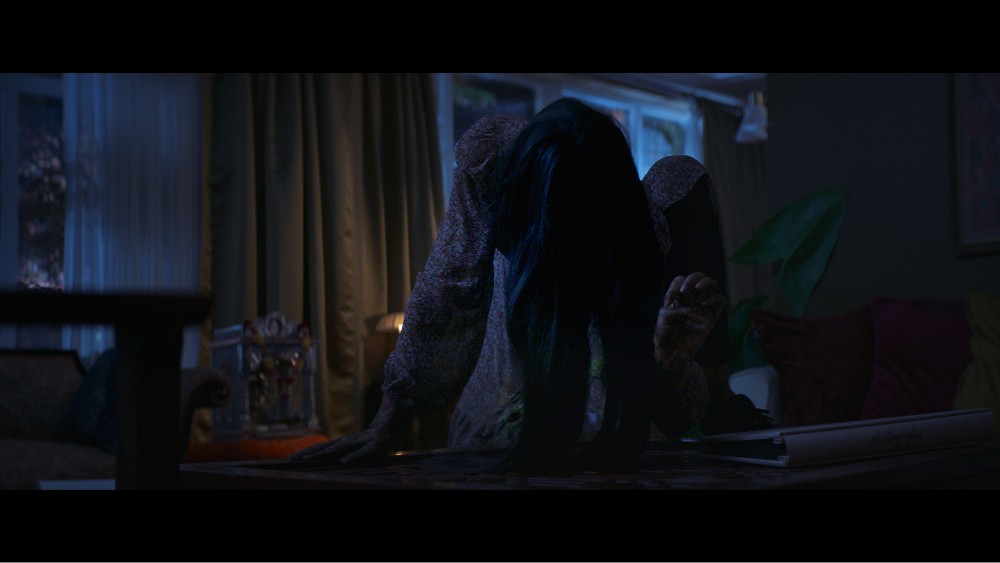
Todd Masters is indeed one of the masters of creature and prosthetic make-up effects, having worked in that world for over 35 years, working on everything from Look Who’s Talking and Addams Family Values, to a lengthy journey into Tales from the Crypt and other known horror franchises.
In more recent years, he and his company MastersFX, which has studios in L.A., Toronto, and Vancouver, have worked on shows like True Blood and Hemlock Grove, although he won his Primetime Emmy for his work on HBO’s Six Feet Under. Masters is also a founding member of the Visual Effects Society (VES).
Recently, Below the Line had the chance to speak with Masters about his work on Bishal Dutta’s It Lives Inside, a distinctly original horror film about an Indian-American teen girl named Samidha (played by Megan Suri) who has been dealing with her own cultural identity, something that becomes more troubling as she encounters an unrelenting supernatural presence.
Much of the work required of Masters and his team involved creating the embodiment of a “Pishacha,” a flesh-eating demon from Hindu mythology that plagues Samidha and the people around her, as she needs to figure out how to trap this demon and keep it from creating further death and mayhem.

BTL: I assume you must have been involved with this movie fairly early on, since the Pishasch plays such a major role. What were your early conversations with Bishal like?
Masters: Bishal, he’s really into this art form, he really loves monsters and monster films and genre stuff, and he particularly likes practical effects. He really wanted something on set that he could continue his painting. He was very much into the fact that we’ve had such a long-standing career in practical as well as mixing it with digital effects. He was curious to engage how unusual we could make this.
Pishasches are really not something familiar to Western culture yet, so we had a little bit of free play with where to go with the design. At the same time, we wanted to make it very nightmarish, very dreamlike, so not a lot of specific monster choices in a traditional sense. We didn’t want it to be Predator. Sometimes, Pishasches are described as vampires, and we didn’t want anything to latch into a a traditional monster, because this thing was so unique. It’s a mythology, it’s a spirit, it’s almost an incantation of your own demon in a way.
Bishal really wanted to film it in such a way that it was revealing, but only in certain ways, so we made a lot of it very dramatic. We even sculpted souls and faces into parts of its body. By working with Jenaya [Ross], she has a very slender form. Her arms and legs and neck are very lean. We can really use that to our advantage and make this creature look very unusual. Where it has quite a bit of a large chest but very slender and lean arms and legs. And then, we have a big animatronic head on it as well.
BTL: Are you doing the design in house, or did Bishal work with another creature designer in the art department separately from Masters FX?
Masters: We did it. I started just doing some really random scribbles, which I don’t think I’ve shown yet, and then our key artist, Chris Devitt, started working on concepts. He did one that really resonated with Bishal, so we developed that with him, until we got something that we were ready to start creating with. And then we did a full-body cast of Jenaya and started creating our practical creature suit on top of it.
BTL: Is the Pishach based on mythology, or just something completely from Bishal’s imagination?
Masters: It’s actually Hindu mythology, and they’re something like a flesh-eater. It’s fascinating, and it’s something that’s fresh to Western cultures, something that they’re going to experience for the first time. It’s not like they’re just gonna go see another werewolf movie. This is a brand-new monster to add to the monster world, so it’s a lot of fun.
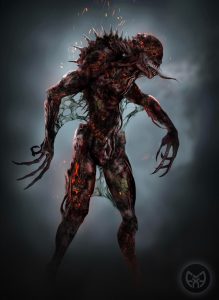
BTL: I actually just went on Google to look at some of the artist renditions of the Pishach, some possibly over hundreds of years. Did any of those influence your designs, did you take bits and pieces and incorporate them, or did you really just want to start from scratch?
Masters: A little of both. Chris and I really wanted to be informed by what was out there and what existed already in the minds of so many people. I just came back from New Orleans, and there’s a werewolf swamp monster legend there, a thing called a Rougarou. I did the same thing. I was on a movie down there, but on my downtime, I started wondering what could this thing be and started designing it. I kind of did the same thing where I looked at what was previously considered. Same thing with the Pishach.
It’s important for us to dip ourselves into the mindset of what’s been conceived before, and certainly get it in our heads. I don’t know of any that we actually borrowed or referenced; I don’t think we did any of that. We kind of just wanted to dip into it, just to see what existed.
From there, it was really creating Bishal’s vision, in terms of how he wanted to create the scenes. He really wanted these sequences to feel almost like nightmares and apparitions, and “Did I just see that?” We wanted to make things that were really graphic, really high-contrast things that were dramatic for the audience, so that’s where we went.
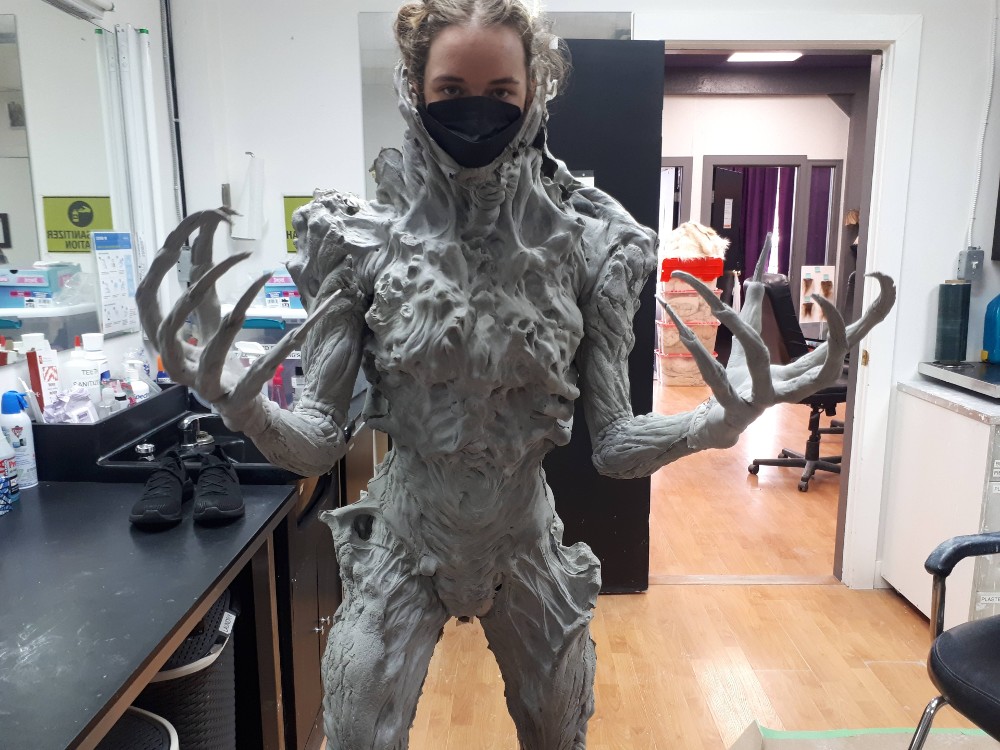
BTL: Is Jenaya Ross somebody you had worked with a lot before, or somebody you brought on board just for this?
Masters: We’ve actually done a lot of stuff with her. She’s a sweetheart. She’s in her early 20s, and she’s like a skateboarder, a hiker, a very physical person. I’m trying to remember the backstory, but I think we met her somewhere, maybe it was on a project, and we really enjoyed working with her. And then, we put her into a bunch of Nancy Drew episodes, and she’s in a couple of series.
We’ve put her in a variety of things, and we keep trying different monsters on her physical body, because she has this wonderfully lean shape, and she’s kind of into it, which is great. She’s a great performer, and we haven’t been able to overwhelm her yet. She’s been on stilts, she’s got hand extensions. She’s had big robotic monster heads on her, and she’s still coming back for more.
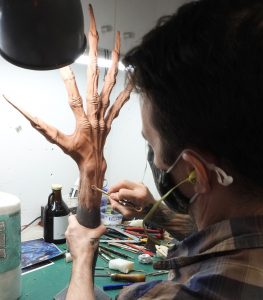
BTL: I assume the Pishach also involves some kind of puppeteering, since there are so many different moving elements of it, so you have other people handling that aspect?
Masters: There were only a couple of people puppeteering on this. It was really the mouth area and some eye stuff. I believe there was a glowing element that I think in the final piece is probably somewhat enhanced by visual effects. We wanted to keep the puppeteering down to a minimum, so it’s mostly Jenaya’s performance with some enhancement.
BTL: How big a crew do you have on set for days when you do have the Pishach?
Masters: I think we had five or six people on set for creature days, but in the studio, we have probably about 20 to 25 people that worked on this.
BTL: Were you working on this out of the Vancouver studio?
Masters: Yeah, we did this in our Vancouver studios, actually in Burnaby, which is just outside of Vancouver.
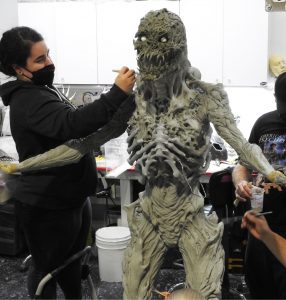
BTL: You mentioned VFX, and I was curious whether you stay involved with what’s being enhanced from what you did on set using VFX?
Masters: Absolutely. We really want to make sure that we’re at least in a handshake with the visual effects crew. In some cases, we’ve even done the visual effects ourselves. But to me, it’s important that this work is continuous from conceptual all the way to the final frame, final pixel if you will.
Sometimes, we get in earlier than visual effects people, so I really like to make sure that we keep a relationship open with everybody, so that the ideas that the ideas that were initially conceived were carried through, so it’s not like they’re getting reinvented. It just keeps things looking better.
BTL: Bishal’s DP Matthew Lynn did a great job making sure the creature looked as good as anything else in the movie, as good as the actors. You definitely see it. It’s not like it’s hidden in shadows, which is sometimes the case. I also liked the fact that I can tell that it’s practical vs. VFX.
Masters: That’s a tricky thing with things that are sort of magical and mythical. I always feel it has some sort of believability, some organic sense when it’s actually there. Even if it’s really good CG, sometimes it feels like a graphic that’s been added, and it loses the power of what you’ve come to see, which is this experience, this magical moment. It’s kind of an odd thing to say. It’s just that you want something practical when you have a magical time. I think the fact that we do have something practical there for the cinematographer to light and for the director to block and the actors to respond to, you’re picking up on that, and I think it matters.
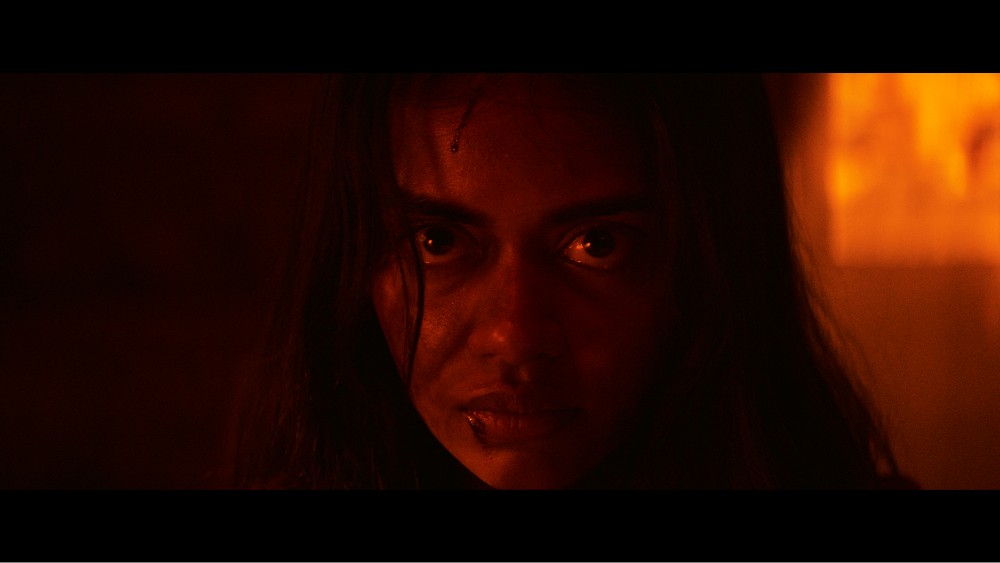
BTL: You’ve been doing this for so long, so is there anything that really challenges you at this point?
Masters: You kind of hit on a few things that I’m really interested in. You mentioned that you knew that it was really there, and I believe you mentioned it was a positive thing. As long as I’ve done this, the work gets better and better, and thirty years ago, it was there, but it wasn’t as dynamic as it might have been. Nowadays, we can make it dynamic. We can make it living, breathing, feeling like it’s there. Maybe it is a slight mix of the practical and the digital. That type of stuff is exciting to me, because it [makes] the audience member more connected to the characters. They’re actually feeling the thing breathing and believing it’s there as well. I think that’s important for the experience.
I guess we’ll find out when this movie comes out how that resonates. For films like this, that really want to have an intimate connection to terror or a nightmare experience, these things really matter. I think the tone of the film really matters. To get that, you need to use these elements that cast and crew can respond to him. That’s cool to hear you say that you’re actually responding to it.
BTL: And the fact that both Jenaya and Megan give really physical performances help sell it as well.
Masters: Totally, and that really matters. You stay with it rather than fake punches. You stay in it, you believe it, you want to enjoy the experience without it all of a sudden becoming artificial.
BTL: Having done this for 30 years, you must have seen how the technology has changed, even if it’s just shortening the time to apply make-up, so how has technology helped with your process in what you do?
Masters: Absolutely, great question. We’re doing quite a bit more. Even since doing this film, we’ve just gotten quite a bit into what we call neo-practical effects. This is the combination of methodologies, where we’re bringing a lot more of our actors and our characters through the computer. We just finished a film, in fact, where we did like 98% of it in the computer, where all the actors were brought in by scans, all the sculptures were done by digital sculpture. The molds were printed, the animatronics were designed and printed in the computer, all the way through the process. It’s really changing our workflow quite considerably.
Much like we were talking about that handshake with visual effects, it allows for that connection to almost be immediate. It’s almost like we’ve completed the journey through the uncanny valley in a way. We’re just really in lock step with the visual effects artists and, and working with them very much in handshake. That, to me, is really exciting, and continuing to make things in a passionate way that gets response from people like yourself. I mean, that’s what it’s all about to me.
It Lives Inside is now playing in theaters across the country.





